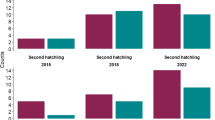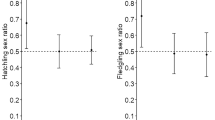Abstract
In sexually size dimorphic species, individuals of the larger sex often suffer from enhanced mortality during the nestling period. This has been attributed to higher nutritional requirements of the larger sex, which may render this sex more vulnerable to adverse food conditions. However, sex-biased mortality might not exclusively depend on the differences in food demand but also on other phenotypic differences, e.g., in competitiveness. Interference competition between the sexes and position in the laying sequence in particular may be essential components contributing to biased mortality.
By creating synchronously-hatched unisex broods in the sexually size dimorphic black-headed gull, we specifically tested the effect of sex-specific food demand by excluding interference competition between the sexes as well as hatching asynchrony. To test the effect of egg quality, which varies with the position in the laying sequence, we composed each nest of chicks from eggs of all different positions in the laying sequence.
All-male nests showed significantly enhanced mortality compared to all-female nests from the beginning of the development of the sexual size dimorphism onwards. This underlines the role of a higher food demand in biased mortality of the larger sex.
In males but not females, asymptotic body mass and skeletal size were negatively associated with position in the laying sequence, while survival was not affected by position. As a consequence, sexual size dimorphism at the end of the nestling period was less pronounced compared to the natural situation. These data show that, although male growth is more sensitive to a decrease in egg quality, the higher mortality of last hatched chicks in natural nests is mainly due to hatching asynchrony and egg size but not egg content.


Similar content being viewed by others
References
Anderson DJ, Reeve J, Gomez JEM, Weathers WW, Huston S, Cunningham HV, Bird DM (1993) Sexual size dimorphism and food requirements of nestling birds. Can J Zool 71:2541–2545
Anderson DJ, Budde C, Apanius V, Gomez JEM, Bird DM, Weathers WW (1993a) Prey size influences female competitive dominance in nestling American Kestrels (Falco sparverius). Ecology 74:367–376
Bradbury RB, Griffiths R (1999) Sex-biased mortality is influenced by hatching asynchrony in the Lesser Black-backed Gull Larus fuscus. J Avian Biol 30:316–322
Blount JD, Surai PF, Nager RG, Houston DC, Møller AP, Trewby ML, Kennedy M (2002) Carotenoids and egg quality in the lesser black-backed gull Larus fuscus: a supplemental feeding study of maternal effects. Proc R Soc Lond B 269:29–36
Bortolotti GR (1986) Influence of sibling competition on nestling sex ratio in sexually dimorphic birds. Am Nat 127:495–507
Clark AB, Wilson DS (1981) The onset of incubation in birds. Am Nat 125:603–611
Clutton-Brock TH, Albon SD, Guinness FE (1985) Parental investment and sex differences in juvenile mortality in birds and mammals. Nature 313:131–133
Clutton-Brock TH (1991) The evolution of parental care. Princeton University Press, Princeton, NJ
Crawley MJ (2002) Statistical computing. an introduction to data analysis using S-plus. Wiley, Chichester, UK
Dijkstra C, Daan S, Pen I (1998) Fledging sex ratios in relation to brood size in size-dimorphic altricial birds. Behav Ecol 9:287–296
Drummond H, Osorno JL, Torres R, Garcia Chavelas C, Merchant Larios H (1991) Sexual size dimorphism and sibling competition: implications for avian sex ratios. Am Nat 138:623–641
Dzus EH, Bortolotti GR, Gerrard JM (1996). Does sex-biased hatching order in bald eagles vary with food resources? Ecoscience 3:252–258
Eising CM, Eikenaar C, Schwabl H Groothuis TGG (2001) Maternal androgens in black-headed gull (Larus ridibundus) eggs: consequences for chick development. Proc R Soc Lond B 268:839–846
Eising CM, Groothuis TGG (2003) Yolk androgens and begging behaviour in black-headed gull chicks: an experimental field study. Anim Behav 66:1027–1034
Gabrielsen GW, Klaassen M, Mehlum F (1992) Energetics of black-legged kittiwake Rissa Tridactyla chicks. Ardea 80:29–40
Gibbons DW (1987) Hatching asynchrony reduces parental investment in the jackdaw. J Anim Ecol 56:403–414
Glutz von Blotzheim UN, Bauer KM (1982) Handbuch der Vögel Mitteleuropas. Band 8. Wiesbaden.
Godfray HCJ (1995) Evolutionary theory of parent-offspring conflict. Nature 376:133–138
Goldstein H (1995) Multilevel statistical approach. Edward Arnold, London
Graves J, Whiten A, Henzi P (1984) Why does the herring gull lay three eggs? Anim Behav 32:798–805
Griffiths R (1992) Sex-biased mortality in the lesser black-backed gull Larus fuscus during the nestling stage. Ibis 134:237–244
Griffiths R, Double MC, Orr K, Dawson RJG (1998) A DNA test to sex most birds. Mol Ecol 7:1071–1075
Green DJ (2002) Pair bond influences paternal provisioning and the primary sex ratio of brown thornbills. Anim Behav 64:791–800
Groothuis TGG, Schwabl H (2002) The influence of laying sequence and habitat characteristics on maternal yolk hormone levels. Funct Ecol 16:281–289
Ihaka R, Gentleman R (1996) R: a language for data analysis and graphics. J Comput Graph Stat 5:299–314
Kalmbach E, Furness RW, Griffiths R (2005) Sex-biased environmental sensitivity: natural and experimental evidence from a bird species with larger females. Behav Ecol 16:442–449
Krijgsveld KL, Dijkstra C, Daan S (1998) Energy requirements for growth in relation to sexual size dimorphism in marsh harrier Circus aerogineus nestlings. Physiol Zool 71:693–702
Mock DW, Drummond H, Stinson CH (1990) Avian siblicide. Am Sci 78:438–449
Nager RG, Monaghan P, Griffiths R, Houston DC, Dawson R (1999) Experimental evidence that off spring sex ratio varies with maternal condition. Proc Natl Acad Sci 96:570–573
Nager RG, Monaghan P, Houston DC, Genovart M (2000) Parental condition, brood sex ratio and differential young survival: an experimental study in gulls (Larus fuscus). Behav Ecol Sociobiol 48:452–457
O'Connor RJ (1978) Brood reduction in birds: selection for fratricide, infanticide and suicide? Anim Behav 26:79–96
O'Connor RJ (1984) The growth and development of birds. Wiley, Chichester, U.K.
Oddie KR (2000) Size matters: competition between male and female great tit offspring. J Anim Ecol 69:903–912
Parsons J (1975) Relationship between egg size and post-hatching chick mortality in the herring gull (Larus argentatus). Nature 228:1221–1222
Pinheiro JC, Bates DM (2000) Mixed-effects models in S and S-plus. Springer, Berlin Heidelberg, New York
Rasbash J, Browne W, Healy M, Cameron B, Charlton C (2000) Multilevel models project. University of London, London
Riedstra B, Dijkstra C, Daan S (1998) Daily energy expenditure of male and female marsh harrier nestlings. Auk 115:635–641
Røskraft E, Slagsvold T (1985) Differential mortality of male and female offspring in experimentally manipulated broods of the rook. J Anim Ecol 54:261–266
Royle NJ, Hamer KC (1998) Hatching asynchrony and sibling size hierarchies in gulls: effects on parental investment decisions, brood reduction and reproductive success. J Avian Biol 29:266–272
Royle NJ, Surai PF, McCartney RJ, Speake BK (1999) Parental investment and egg yolk lipid composition in gulls. Funct Ecol 13:298–306
Royle NJ, Surai PF, Hartley IR (2001) Maternal derived androgens and antioxidants in bird eggs: complementary but opposing effects? Behav Ecol 12:381–385
Sayce JR, Hunt GL (1987) Sex ratios of prefledging western gulls. Auk 104:33–37
Stockland JN, Amudsen T (1988) Initial size hierarchy in broods of the shag: relative significance of egg size and hatching asynchrony. Auk 107:359–366
Teather KL (1992) An experimental study of competition for food between male and female nestlings of the red-winged blackbird. Behav Ecol Sociobiol 31:81–87
Torres R, Drummond H (1997) Female-biased mortality in daughters of a bird with size dimorphism. J Anim Ecol 66:859–865
Torres R, Drummond H (1999) Does large size make daughters of blue-footed booby more expensive than sons? J Anim Ecol 68:1133–1141
Vedder O, Dekker AL, Visser GH, Dijkstra C (2005) Sex-specific energy requirements in nestlings of an extremely sexually size dimorphic bird, the European sparrowhawk (Accipiter nisus). Behav Ecol Sociobiol DOI: 10.1007/s00265-005-0926-6.
Velando A (2002) Experimental manipulation of maternal effort produces differential effects in sons and daughters: implications for adaptive sex ratios in the blue-footed booby. Behav Ecol 13:443–449
Acknowledgements
The study was made possible by a Ph.D. studentship to WM from the University's Center for Behaviour and Neurosciences. We thank all organizations and landowners from the Linthorst–Homan polder and the Havenschap Delfzijl for giving us the permission to work on their properties. Jenny de Vries and Gerard Overkamp contributed to the successful procedure with cross-fostering and following the chicks. The experiment was performed under proper legislation by the Dutch law and approved by the Animal Experimentation committee of the University of Groningen under license DEC 2698
Author information
Authors and Affiliations
Corresponding author
Additional information
Communicated by I. Hartley
Rights and permissions
About this article
Cite this article
Müller, W., Kalmbach, E., Eising, C.M. et al. Experimentally manipulated brood sex ratios: growth and survival in the black-headed gull (Larus ridibundus), a sexually dimorphic species. Behav Ecol Sociobiol 59, 313–320 (2005). https://doi.org/10.1007/s00265-005-0045-4
Received:
Revised:
Accepted:
Published:
Issue Date:
DOI: https://doi.org/10.1007/s00265-005-0045-4




